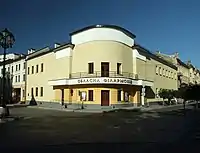Stanisław Trela (1892–1950[1]) was a Polish architect best known for his designs of public utility buildings in interwar Ivano-Frankivsk (then Stanisławów, Second Polish Republic).[2][3]



Trela was born on 19 April 1892 in Żurawiczki, Austria-Hungary. His father was a teacher. He finished his school education in Przemyśl and in 1913 started to study architecture at Lemberg Polytechnic. In 1918–1919, he served in the Polish Army. He was promoted to the rank of lieutenant. Trela received his degree in architecture in 1924, and a year later moved to Stanisławów where he worked as the city architect from 1928 to 1932.[2][3] He also presided over the local Society of Independent Construction Managers[2] and was a member of the Polish Polytechnical Society.[4]
Trela was a student of noted architect Witold Minkiewicz. His architectural style combined modern and traditional elements.[2] He often incorporated a simplified monumental classicism to his projects.[3]
Projects
His major works in Ivano-Frankivsk (Stanisławów) included:[2][1][5]
- Town Hall
- Roman Catholic Church in Górka district
- Stanisław Moniuszko Municipal Theater at Mickiewicz square (now Ivano-Frankivsk Concert Hall, Les Kurbas street)
- Expansion and reconstruction of the "Sokół" Gymnastic Society building (originally designed by Karol Zaremba in 1894–1905)
- The "Ton" cinema
- School complex in Matejki street (now the city's hospital)
- Craftsmen's hall of residence in Sobieski street
- Fire brigade building
- Restoration of Armenian Church
References
- 1 2 Chmielewski, Wojciech Jan; Zawada-Pęgiel, Katarzyna; Złowodzki, Maciej (2019). "O architekturze zachodniej Ukrainy w aspekcie estetyczno-wrażeniowym nostalgii historycznej". Teka Komisji Urbanistyki i Architektury Oddziału Polskiej Akademii Nauk w Krakowie (in Polish and English). Polish Academy of Sciences Kraków. 47: 93. ISSN 0079-3450.
- 1 2 3 4 5 6 Pszczółkowski, Michał (2013). "Architektura Stanisławowa II Rzeczypospolitej". In Walczak, Wojciech; Łopatecki, Karol (eds.). Stan badań nad wielokulturowym dziedzictwem dawnej Rzeczypospolitej. Vol. IV (in Polish and English). Instytut Badań Nad Dziedzictwem Kulturowym Europy. pp. 392–400, 415. ISBN 9788393492077.
- 1 2 3 Ostrowski, Jan K. (2006). "Stanisławów. Wiadomości na temat miasta i jego zabytków". Materiały do dziejów sztuki sakralnej na ziemiach wschodnich dawnej Rzeczypospolitej: Kościoły i klasztory rzymskokatolickie dawnego województwa ruskiego. Vol. 14. Jagiellonian University. p. 325. ISBN 9788389273420.
- ↑ Matakiewicz, Maksymiljan, ed. (1927). Polskie Towarzystwo Politechnicze we Lwowie 1877-1927: Księga Pamiątkowa. p. 96.
- ↑ Chrząszczewski, Jacek (1996). "Kościół Ormiański w Stanisławowie". In Ostrowski, Jan K. (ed.). Sztuka Kresów Wschodnich: Materiały sesji naukowej, Kraków, maj 1995. Vol. 2. Jagiellonian University. p. 170.